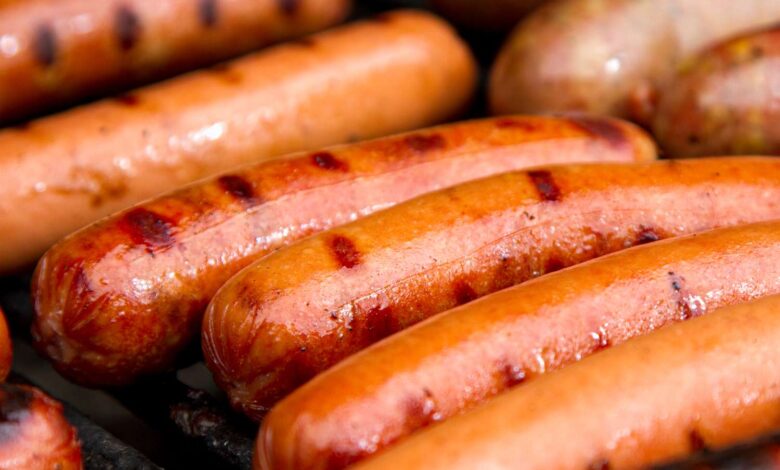Stop Ruining Hot Dogs—Learn This Before Your Next Cookout

In a Nutshell
- Direct high heat is the enemy of juicy hot dogs. Skinless dogs shrivel and dry out fast, while natural-casing franks risk bursting if overheated.
- Slash skinless dogs before grilling to help them heat evenly and stay plump (no more leathery, deflated franks).
- Simmer cased dogs first, then grill for char and snap without losing their juicy interior.
It was a classic backyard scene: The grill was hot, the buns were soft, the condiments were lined up and at the ready. And yet, the hot dogs—my pièce de résistance—looked sad, wrinkled…deflated. Instead of plump, snappy franks, I had leathery tubes. How had I messed up something so seemingly foolproof?
It turns out that grilling hot dogs is more nuanced than just tossing them over the hot coals until they “look good.” That realization hit me mid-cookout, and it sent me on a mission to figure out how to keep my hot dogs juicy and snappy every time.
This was years ago, before I had written grilling cookbooks and developed many grilling recipes as an editor at America’s Test Kitchen. After this experience, I found Joshua Bousel’s hot dog method on Serious Eats. It has completely changed my hot dog grilling game and I still use this technique today.
Why Hot Dogs Shrivel on the Grill
Let’s get one thing out of the way: Most hot dogs are fully cooked when you buy them. But that doesn’t mean they’re ready to eat straight out of the package or that grilling them is as simple as it seems.
The biggest offender? Direct, high heat. When you throw a frank straight onto a hot grill, it may look great while it’s cooking—plump and glistening. But once you take it off the heat, it deflates like an old balloon. The exterior dries out fast, leaving you with a chewy, leathery skin instead of the tender snap you want.
The problem is how heat affects the hot dog’s structure and moisture. Both skinless hot dogs and natural-casing franks are vulnerable, but in different ways.
Skinless Hot Dogs
Skinless dogs are particularly vulnerable because they lack a protective outer casing. They’re formed in synthetic molds, then peeled before packaging, leaving the meat exposed. Unlike their natural-casing counterparts, they lack an outer membrane to contain moisture. When you place them directly over high heat, especially over roaring flames or blazing coals, the intense temperature causes the outer layers of the sausage to cook too quickly.
As the proteins near the surface denature and contract (mainly myosin and actin), they squeeze out moisture and fat. Because the hot dog is already cooked, there’s no raw structure left to firm up or trap those juices. The center remains relatively cool, while the outer layers dehydrate and tighten, creating a wrinkled, chewy shell—like overcooked scrambled eggs pulling from a pan.
This rapid surface dehydration is what gives the frank its papery, leathery skin. On top of that, without a casing to buffer or trap steam, internal pressure builds unevenly. When that pressure is finally released (i.e., when the dog is removed from the grill), the hot dog deflates. Think of it as an edible balloon that’s lost its air.
Natural-Casing Hot Dogs
Natural-casing hot dogs, on the other hand, are stuffed into sheep intestines, which behave a lot like sausage casings—they’re elastic, semi-permeable, and capable of retaining juices. That casing creates a barrier to both heat and moisture, so the internal temperature rises more gradually and evenly, protecting the meat inside from drying out prematurely. As a result, cased dogs are more forgiving on the grill and are less likely to shrivel.
However, they’re not completely invincible. If you blast them over ripping-hot coals, the pressure of expanding steam and liquefied fat inside can cause the casing to split or rupture, especially if there’s no vent or weak spot to release pressure. Once the casing bursts, all that delicious juice runs out—and you’re left with a dog that’s dry and limp instead of snappy and juicy.
In short, both types of hot dogs have vulnerabilities when faced with high, direct heat:
- Skinless: loses moisture quickly without a casing.
- Cased: holds moisture better but can burst if overheated.
That’s why a little technique can go a long way toward grilling perfection.
The Simple Trick for Better Skinless Hot Dogs
Enter Bousel’s technique: slashing your hot dogs before they hit the grill.
For skinless hot dogs, making a few shallow, diagonal cuts on two opposite sides of each frank helps distribute heat more evenly. Those slits expand during cooking, helping the center to heat faster and reducing overall cook time. The result? Plump, juicy hot dogs that don’t shrivel and have a lightly crisped exterior with just the right bite.
You can even get fancy and try the spiral-cut method—skewer the hot dog and make a single continuous cut as you rotate it. It’s eye-catching and adds surface area for extra browning, but it’s also easier to overcook. For me, the simple slash is quicker, foolproof, and just as tasty.
How to Keep Cased Franks from Bursting
The method changes slightly if you’re lucky enough to score natural-casing hot dogs (and you should—it’s the easiest way to upgrade your hot dog game). Those casings add protection, prevent the meat from drying out. But as described above, they can still split under high heat, which means you can lose all those delicious juices.
To avoid this, Bousel borrows a trick from Kenji López-Alt’s sausage playbook: start with a grill-side hot-dog hot tub.
In a cast iron skillet (or a disposable aluminum pan if you’re outdoors and traveling light), simmer your cased dogs in a mix of beer and either sauerkraut or stewed onions. This indirect cooking phase gently brings them up to temperature. Then, move them over direct heat for a quick char. This two-step method locks in juiciness and gives you that coveted snap without risking a burst.
Serious Eats/ Getty
The Bottom Line
Grilling hot dogs might not sound like rocket science, but a few minor tweaks can be the difference between a cookout hero and a soggy disappointment.
- Slash skinless dogs before grilling for even cooking and plump texture.
- Simmer cased dogs in a flavorful liquid before finishing on high heat to keep them juicy and intact.
Now, whenever I fire up the grill, I know my hot dogs won’t let me down. No more shriveled regrets—just juicy franks, sizzling buns, and happy guests.





